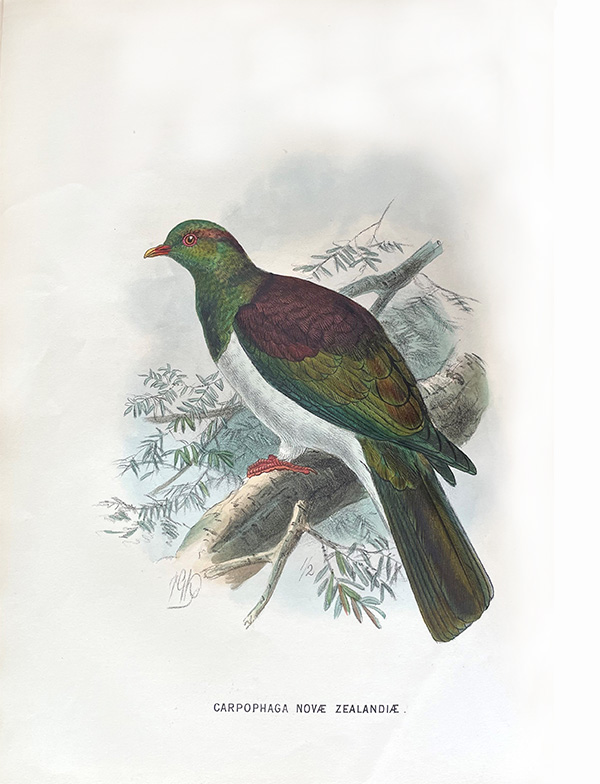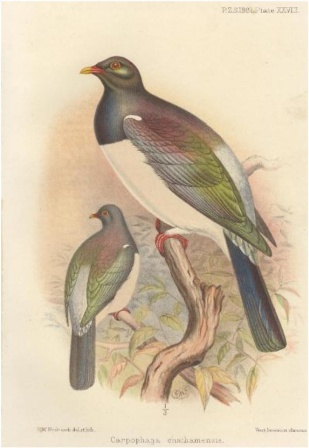


Kereru, from Walter Lawry Buller's, Birds of New Zealand, 1873.
Talking to a neighbour down at the garage the other day, he asked if I had seen any Kereru, our native wood pigeons. I said, “No. I’ve done everything though, to entice them down into my garden but, no luck.”
He told me that this last winter he had had up to 30 birds at any one time in a grove of tree lucerne he had planted for their benefit. “They strip the trees bare”, he said, “which worries me as I don’t seem to be able to grow enough for them. They are not long lived trees so I will need to plant some more to take over when this lot give up the ghost.”
I told him I had planted tree lucerne all over the place in my part of the Valley but the pigeons had studiously continued to ignore my efforts. I had, however, often watched them flying over head, readily identified by the steady beat of their wings, undoubtedly to my neighbour’s patch in the hills above the Valley. My Kowhai and Houhere trees did not tempt them either although they are reputed to flock to them during feed shortages in the late winter and early spring.
I went away home, feeling thoroughly spurned by our local Kereru but pleased to hear that there were as many as 30 in our neck of the woods for it is a splendid bird and the aristocrat of the Columbidae family which includes doves. With its head, throat and upper breast and back a metallic green flecked with gold and with a purple sheen, its belly white and its eye, beak and feet crimson, it is truly a gorgeous bird.
Kereru is a forest bird, favouring lowland forest dominated by podocarps, tawa, taraire and puriri, but it can now be found in bush patches on farmland, in gardens and in parks in cities. Their breeding and wintering distributions are similar but birds will move long distances to good sources of fruit or foliage outside the breeding season.
Berries are the Kereru’s favourite food all the year round — Puriri in the summer and autumn, Miro in the autumn and winter and Taraire in the winter and spring. Karaka, Nikau and Kahikatea and other berries also supplement their diet where available. During the late winter when there are few or no berries, leaves and shoots provide sustenance.
Nesting usually occurs in spring or early summer and their mating is characterised by spectacular aerial displays, by both sexes but particularly males, close to the time of egg laying. I have often watched them flap upwards from a perch, stall and dive, doing the “loop de loop”. By way of explanation for this remarkable behaviour, the locals say they get drunk on Puriri berries, but according to a DOC report, “When a pigeon flies from its perch, glides up to a vertical stall and then glides down to return to the original perch or fly off somewhere else, the perch from which the kereru flies gives the best indication of the general location of its nest.”
They lay one egg which is peculiarly long, narrow and white. Both adults brood the egg during the 28 day incubation period. The hen sits through the night and morning with the cock taking over from midday until the evening.
Apart from Emperor penguins and flamingoes, pigeons and doves are the only birds to produce food for their chicks. They feed their chicks, called squabs, crop-milk, a protein rich, cottage cheese like secretion from the crop wall. At first crop milk is the only food but, as chicks grow, regurgitated foods form an increasingly large share of the diet.
Like many long lived birds, Kereru breed very slowly. Studies in Northland, Hawkes Bay and Marlborough have found that fewer than 15 per cent of chicks survive long enough to become independent. If this decline continues the species will not be able to sustain itself. Although habitat loss is a major concern, the most serious threat comes from predators, especially Homo sapiens.
Their conservation is important because they play a key ecological role in the regeneration of native forest by dispersing seeds of trees and shrubs such as Miro, Tawa, Karaka, Puriri and Taraire, too large to be dispersed by other birds.
A couple of years ago, the Waikato and Bay of Plenty Conservation Boards initiated a Kereru counting project aimed at farmers with remnants of bush on their land. The project was also aimed at encouraging landowners to fence off bush, to trap and poison predators and plant tree lucerne in the short term while native trees recovered or became established. It is good to see that many landowners have picked up the challenge and adopted these birds as their own.
Kereru is usually a silent bird, something which can be unnerving when one finds them sitting on a branch, usually in the deep shade of a tree quietly observing one. A soft “ku” is sometimes heard along with the growl of the hen bird and the slightly sibilant whistle of welcome to their own. The various Maori names, kuku, kereru, kukupa, tend to be onomatopoeic. They also reputed to sometimes shower in light rain, turning over with feet firmly gripping a branch to allow the rain to fall on their bellies.
Unlike most birds, pigeons can drink without raising their heads to swallow. They become especially thirsty while eating berries, something Maori used to their advantage in hunting them. They would place drinking troughs with nooses beneath berry bearing trees. I am told that these troughs were still in use not too many years ago in the upper reaches of this Valley.
There are two sub species, novaeseelandiae, which breed on the three main islands and chathamensis, which breed on the Chatham Islands and which are a larger bird. A third sub species is extinct, spadicea which survived on Norfolk Island until the 1800s.
They seem totally unafraid of man which is much to their detriment. They are entirely vegetarian not even feeding insects to their young as do the honey eaters. Harmless as a dove is an old adage, and like the dove the symbol of purity and peace, they are faithful to their mates, defenseless, gentle and innocent of sin.
Narena Olliver — Waiotahi Valley, Opotiki, 1998.

| Taxonomy | |
|---|---|
| Kingdom: | Animalia |
| Phylum: | Chordata |
| Class: | Aves |
| Order: | Columbiformes |
| Family: | Columbidae |
| Genera: | Hemiphaga |
| Species: | novaeseelandiae |
| Sub Species: | novaeseelandiae, chathamensis, |
Kuku, kukupa, New Zealand wood pigeon.
Endemic bird
51 cm., 650 g., (NZ), 800 g., (Chatham Islands): head, throat and upper breast and back a metallic green flecked with gold and with a purple sheen, its belly white and its eye, beak and feet crimson.
Widespread but not common.
Poetry: —
“O little sobbing Pigeon,
Why do you moan and groan
Coo-a, O coo-a, coo-a!
Like some old crying crone.
O breast of soft, soft silver,
O plumes of summer blue,
Lo, winter summer, autumn
All gave their best to you.
But spring, Ah, spring forgot you
She fled by you unseen,
With blue, and bronze, and silver
Do you regret the green?
“Not for the spring I’m weeping:
Sweet are the berries then,
Ah, sweet the shining miro
My fear is all for men.
And worse than men, the quail-hawk,
That bird that keeps no law.
I fear its rushing pinion,
I fear its crushing claw.”
Ah, little sobbing Pigeon,
Sob, low, low, low!
God cannot rest in Heaven,
When you are crying so.
O breast of soft, soft silver,
O plumes of summer blue,
O leaf-burnt bird of autumn,
He comes to comfort you.
— Eileen Duggan
Buller, Walter Lawry, Birds of New Zealand, 1873.
Proceedings of the Zoological Society, 1881.
Heather, B., & Robertson, H., Field Guide to the Birds of New Zealand, 2000.
Oliver, W.R.B. New Zealand Birds, 1955.

Proceedings of the Zoological Society, 1881.
Wednesday, 20 September, 2023; ver2023v1